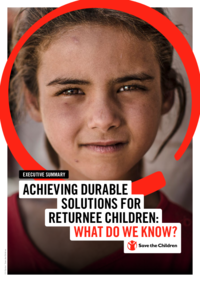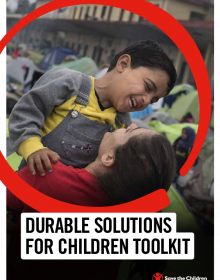
Reports, Study: Research
Achieving Durable Solutions for Returnee Children: What do we know?
Publication year:
2019
English
Format:
pdf (567.7 KiB)
Publisher:
Save the Children
We are in the midst of a profound ‘returns-first’ shift in the global politics of child displacement. In response to soaring numbers of displaced worldwide –68.5 million, of which more than half are children – governments around the world are increasingly pursuing strategies that promote returns over other alternatives such as resettlement and local integration.
Re-entering one’s place of origin after a period of displacement should mark a return to normality. However, when refugee and internally displaced children return home, they rarely return to the life they used to know. Instead, they often reintegrate into societies that are not sufficiently resourced to support them, or which infringe on their human rights.
There is very little data available on the subject, partly because the existing tools used to answer these questions are ‘child blind’ but as returns reach record highs, two fundamental questions arise: how do we guarantee minimum standards for safe and dignified returns, and how do we measure the extent to which children have successfully reintegrated into their communities?
Save the Children’s Migration and Displacement Initiative (MDI) addresses both of these questions in its new global returns report: Achieving Durable Solutions for Returnee Children. Drawing on the best currently available data, and building on the MDI’s recently released Durable Solutions for Children Toolkit, the report offers one of the first comparative child-focused analyses of reintegration conditions across four priority returns contexts: Iraq, Afghanistan, Somalia, and Syria. From these findings, we offer a series of recommendations that we hope will improve our collective knowledge base and improve standards of programming, policy, and advocacy in support of child returnees and their families.
Read full abstract
Authors
View & Download
Document information
Publisher
Authors
Format
Content type
Country
Rights
© Author/Publisher
Found a mistake? Help us improve!
If you have noticed a document assigned to the wrong author or any other inaccuracies, let us know! Your feedback helps us keep our data accurate and useful for everyone.
Related Documents
Share
Link

